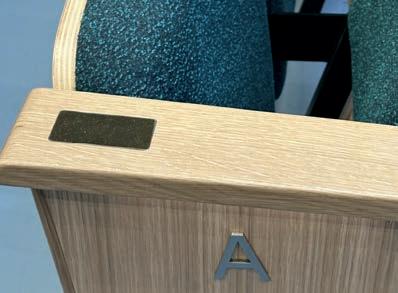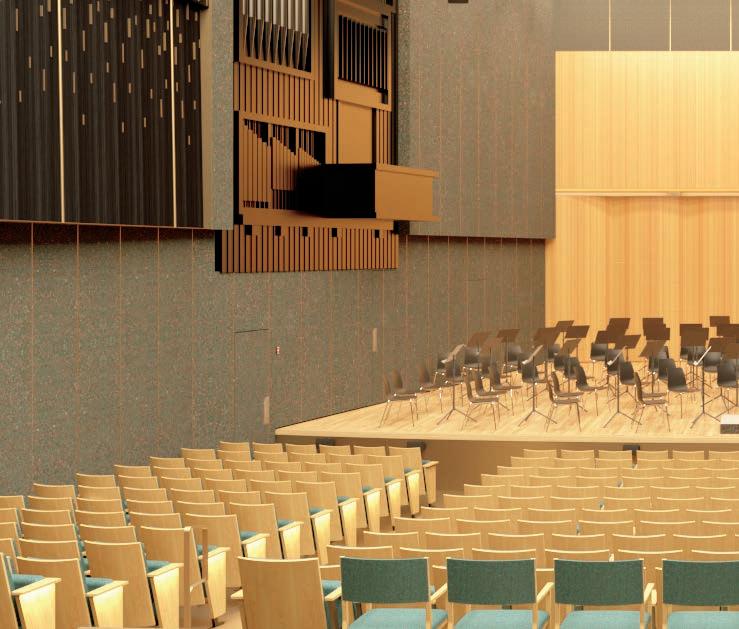

WELCOME
Welcome to a new era at CIM as we stand on the threshold of a transformative moment in the storied history of the Institute. With hearts full of gratitude and spirits ablaze with inspiration, we unveil the magnificently reimagined Kulas Hall—a beacon of artistic innovation and a testament to our shared vision for the future of classical music. This is not merely a renovation; it is a bold declaration of CIM’s enduring commitment to excellence, a bridge spanning our proud past and an exhilarating future.
This moment is a pinnacle in a decade of extraordinary renaissance at CIM. From inspiring student achievements to unprecedented philanthropic support, from the opening of a state-ofthe-art student housing and practice room complex to the triumphant reaffirmation of our 10-year academic accreditation, CIM has been a model of progress. Now, with the rebirth of Kulas Hall, we have crafted a world-class venue that honors the giants of our past while empowering the artists of tomorrow. This hall, our largest classroom and performance space, is a modern marvel—vibrant, versatile, and visionary—designed to meet the artistic demands of the 21st century and beyond.
In the annals of CIM’s history, today shines as brightly as our founding in 1920, our relocation to University Circle in 1961, and the commissioning of Mixon Hall in 2007. The reimagined Kulas Hall writes a new chapter in Cleveland’s narrative, a city long celebrated as a global capital of music. This space is more than a stage; it is a crucible where creativity is forged, where performers and audience members alike will find inspiration to redefine the boundaries of artistic expression.
The impact of Kulas Hall will resonate far beyond these walls. For our students, it is a transformative gift—a platform that further aligns CIM with the world’s premier conservatories, equipping them to become the very best versions of themselves. For our community, it is a vibrant stage for collaboration, a space where the region’s cultural vitality will flourish. We have built the future of concert halls so that our students can claim their place as the future of classical music.
This monumental achievement was no impetuous endeavor. It is the culmination of 25 years of visionary planning, unwavering dedication, and extraordinary generosity. Like a masterwork performed by our students, alumni, and faculty, this project was approached with meticulous care, blending bold ambition with disciplined execution. The project is indebted to Nancy W. McCann, president of the Kulas Foundation for her early contributions, trust, and advocacy. The Kulas Hall Renovation Task Force, led with unrelenting commitment by CIM Trustee Bonnie M. Cook (BM ’77), alongside the exemplary early leadership of Eric W. Bower (BM ’82) and later Brian J. Foss, ensured that every decision honored both artistic integrity and fiscal responsibility.
Our gratitude extends to the talented team that brought this vision to life. Threshold Acoustics, paired with the architectural firm of J. KURTZ, crafted a design that sings with innovation. Turner Construction, alongside their partners at Algebra AEC, Barber & Hoffman, Cost+Plus, and Theatre Projects, transformed this vision into a breathtaking reality—delivered on time and on budget. Their collaboration was a symphony of professionalism, precision, and passion. To all involved: Bravi tutti!
As we gather to experience live music, after 20 months of tireless effort, shared sacrifice, and remarkable charitable donations, Kulas Hall stands ready to inspire generations. Your presence underscores a truth we hold dear: Cleveland is a musical capital of the world, and CIM is at its heart. Together, we celebrate not just a renovated hall, but a renewed promise—a commitment to nurturing the transformative power of music for all who pass through these doors.
Welcome back to Kulas Hall. Let us step boldly into this new era, together.
With profound gratitude,

Susan A. Rothmann, PhD

Paul W. Hogle Chair, Board of Trustees President | CEO
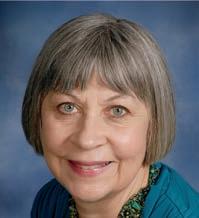
of Trustees
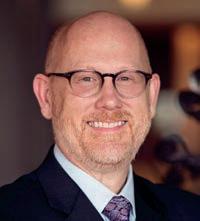
| CEO
Paul W. Hogle President
Susan A. Rothmann, PhD Chair, Board
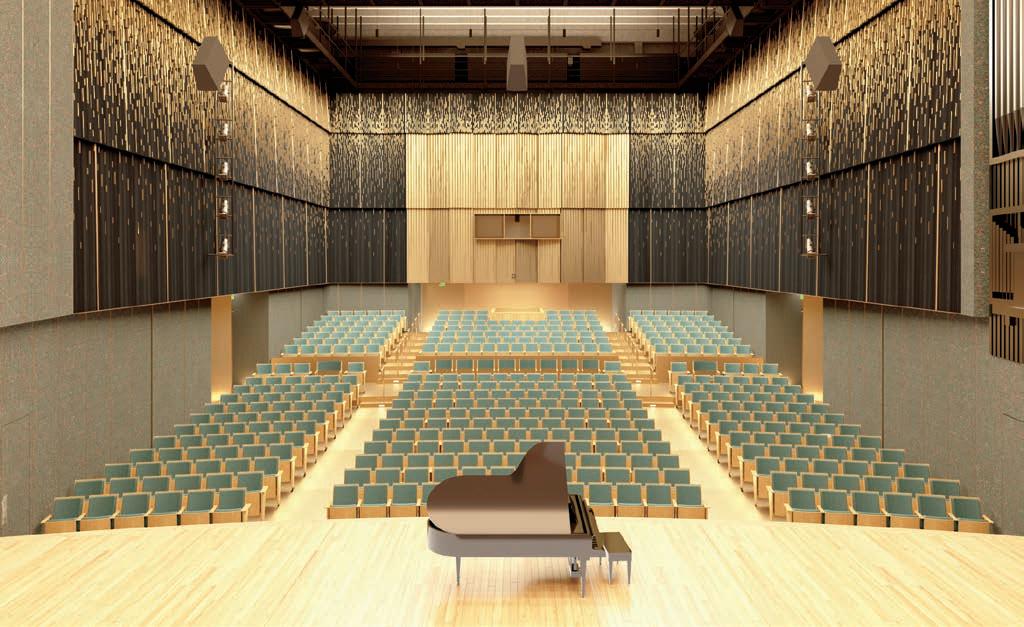


Stories written by Zachary Lewis. Graphic design by Tom Putters.
Photos by Dario Acosta, Tim Bates, Anders Brogaard, Scott Jackson, Seth Jacobson, Caira Lee, Shevaun Williams, Turner Construction,
Cleveland Institute of Music
Friday, October 3 7:30pm | Kulas Hall
GRAND REOPENING CELEBRATION
CIM Orchestra
Carlos Miguel Prieto, guest conductor
Kulas Foundation Visiting Artist
Fani’ (Squirrel) Jerod Impichchaachaaha’ Tate (MM ’00) from Woodland Songs (2025) (b. 1968)
Jingdian Zhou, tenor
Piano Concerto No. 1, “Latin” (2016)
Gabriela Montero
Mambo (b. 1970)
Andante moderato
Allegro Venezolano
Gabriela Montero, piano
Sensemayá (1938)
Symphony No. 2, “Sinfonía India” (1936)
intermission
Silvestre Revueltas (1899–1940)
Carlos Chávez (1899–1978)
Huapango (1941)...........................................................................................................José Pablo Moncayo (1912–1958)
Scan the QR code or visit cim.edu/file/kulas to view the complete concert program.

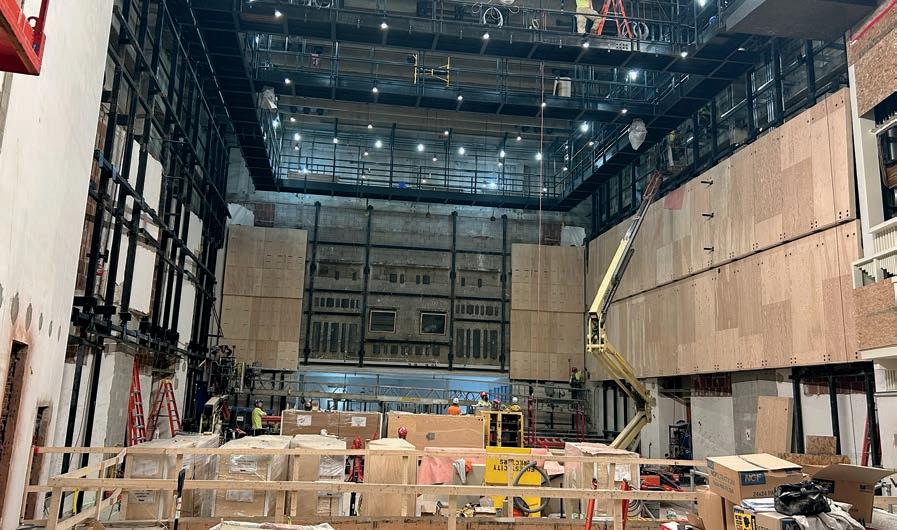
Renovated Kulas Hall ranks as musical and technical triumph
There are two angles from which to approach the new Kulas Hall: the technical and the aesthetic. Both, however, lead to the same point.
Whether considered as a concert space or a feat of engineering, the newly renovated venue at the heart of CIM is bound to impress, to elicit admiration from casual and serious observers alike.
“I don’t feel there are any concessions on this project,” said lead architect Jonathan Kurtz, head of Cleveland-based J. KURTZ Architects.
“Every tension between aesthetic and visual performance resulted in a recrafting, not a compromise. It’s such an integrated result. People who experience it for the first time after the renovation, I’m not sure they’ll even concede it’s the same space.”
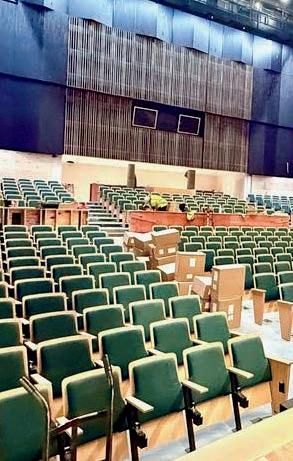
Start where those who conceived the project started, with the acoustics—that is to say, the aesthetics. All the technical accomplishments aside, the new Kulas represents the complete transformation of a beloved but flawed room into the very model of a modern concert hall.
Warm, intimate, and acoustically flexible, the new Kulas does more than invite close listening. It enfolds listeners in a kind of sonic embrace, surrounding them with music and enabling them
to savor everything from the grandest to the most refined of musical gestures.
The same is true in a visual sense. The hall’s darker, gold-tinged color palette was selected in part for its focusing and intimate qualities, for its ability to shut out the world and foster in patrons a sense of communion with each other and the artists on stage.
Performers, meanwhile, are enjoying something similar. On the new stage, all musicians—not just pianists or singers—are able to truly make music together, to hear themselves and each other, and thereby contribute to a clear and balanced whole. This, in turn, fully serves CIM’s mission to prepare students for careers at the top of their fields, in the world’s premier venues.
“I think of [Kulas] as some of the most gratifying work we’ve done, because the entire team shared a vision of an architecture that had to perform,” Kurtz said. “There was something really rewarding about working within constraints that don’t even enter the minds of most architects in conversations about any project, like how a wall is going to sound.”
Many of those same constraints also factored significantly into other aspects of the project. Beyond the acoustics, the size, location, and other physical parameters of Kulas Hall also inspired some seriously creative engineering, all of which now
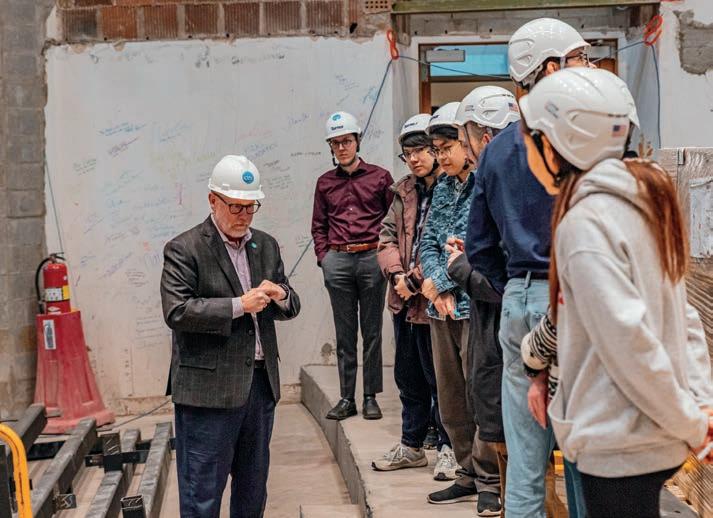
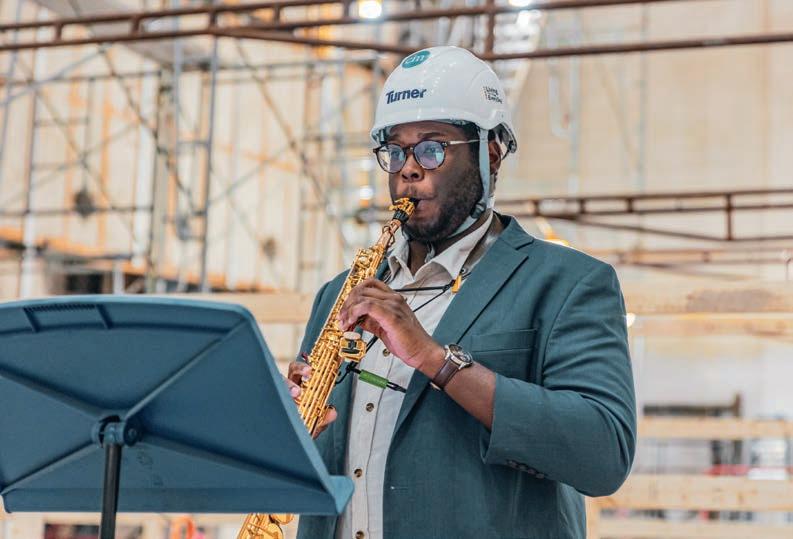
stands to be admired alongside the hall’s look and sound.
One of the biggest and most profound constraints was the project’s location. Because Kulas lies at the literal and figurative heart of CIM, Kurtz and crew had to work within the room’s existing dimensions. Expansion or total redevelopment were not options, as they might have been at a new or freestanding site.
Location also affected how and when construction took place. Unable to completely cordon off Kulas Hall from the rest of CIM, crews had to find ways to maximize productivity while minimizing impact on faculty, staff, and students, by working early or late and completing certain tasks off-site.
“Everything had to be achieved within that space,” Kurtz explained. “We wouldn’t have arrived at this design without these design parameters. All of those practical constraints were where creativity lived for us.”
Perhaps the most complex technical problem was the ceiling, which in the old Kulas was low and covered a network of vital heating and cooling equipment and ductwork. All of that equipment needed to be preserved in the new hall, and yet it also needed to be relocated away from the stage for numerous acoustical reasons.
In the end, designers took the high road, literally. They moved HVAC equipment onto the roof and re-routed the ductwork up, away, and even outside, eliminating the potential for mechanical noise or vibration. At the same time, the rerouting unlocked a whopping 30 percent of new volume at the top of the room, significantly improving the hall’s overall acoustics.
It was the ideal solution to what chief acoustician Dawn Schuette, a partner at Chicago-based Threshold Acoustics, described as a uniquely challenging problem. “Trying to build inside this shell, the hardest part was how to reform the room with the structural limitations we had,” she said.
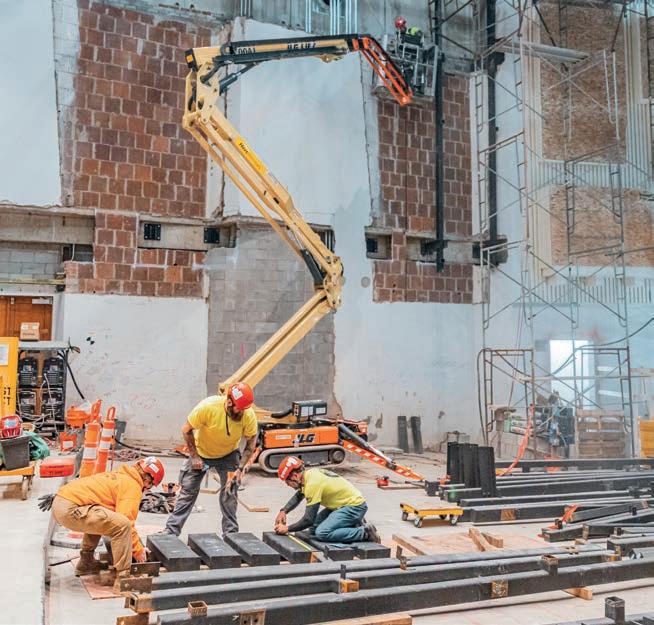
Some of the project’s most ingenious design work, though, emerged from determining how best to line the walls. Acutely mindful of how much weight the original brick-and-mortar side walls could support, Kurtz and Threshold devised a brilliant solution, one that met all the criteria related to engineering, acoustics, and appearances.
Credit our friends the bees for this element. The central (but hidden) feature of the new walls is a honeycomb system, panels of dense, rigid industrial cardboard.
These mimic the acoustic effects of a solid material, such as brick, but weigh significantly less. Dozens of these intricate honeycombs now line the walls, beneath the surface, hanging like picture frames on a large steel structure bolted into the walls.
The coup de grâce is the surface. Affixed onto the honeycomb structures are large panels of wood terrazzo, a new product fabricated in England and boasting recycled materials.
Much like the honeycombs, the stiff, reflective terrazzo panels offer the desirable acoustic effects of weightier materials but don’t come anywhere close to taxing the load-bearing capacity of the walls.
“It’s a novel solution to a very complex problem,” Kurtz said. “We think it’s pretty cool.”
It’s more than cool, however. It’s also elegant, another example of ingenuity and aesthetics operating hand in hand.
Time and again throughout the Kulas renovation, workers and designers displayed remarkable creativity, solving technical challenges while prioritizing the hall’s appearance and performance. Indeed, in the opinion of Bonnie Cook (BM ’77), chair of the Kulas Hall Renovation Task Force, that’s what makes the project so special.
“To be a good experience for everybody, a room needs to look good and function well,” she said. “I think the versatility of the new Kulas Hall is going to serve everyone so much better. It’s a wonderful representation of our school.”
KULAS HALL THROUGH THE YEARS
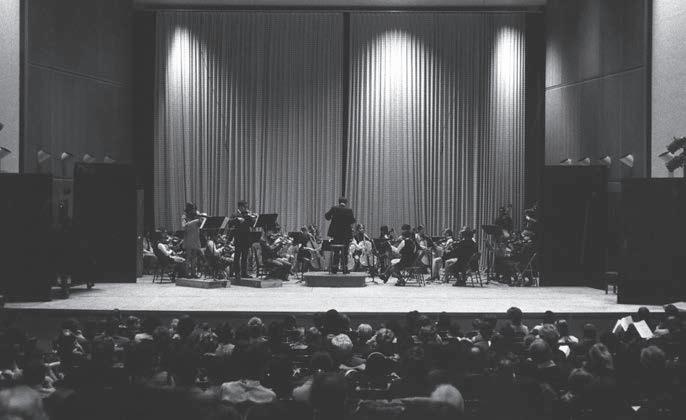
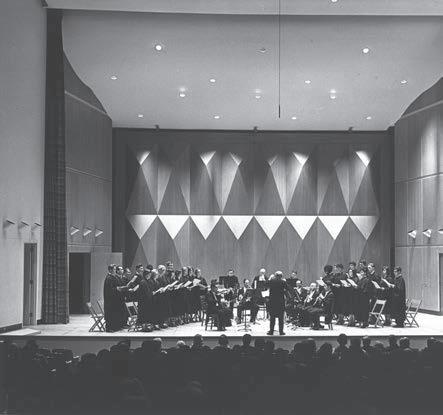

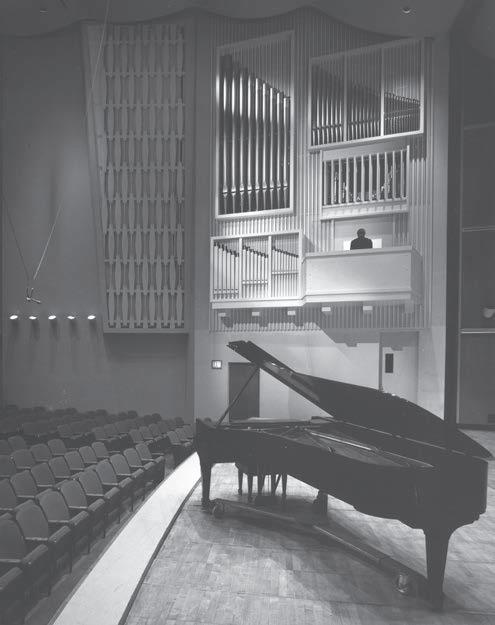
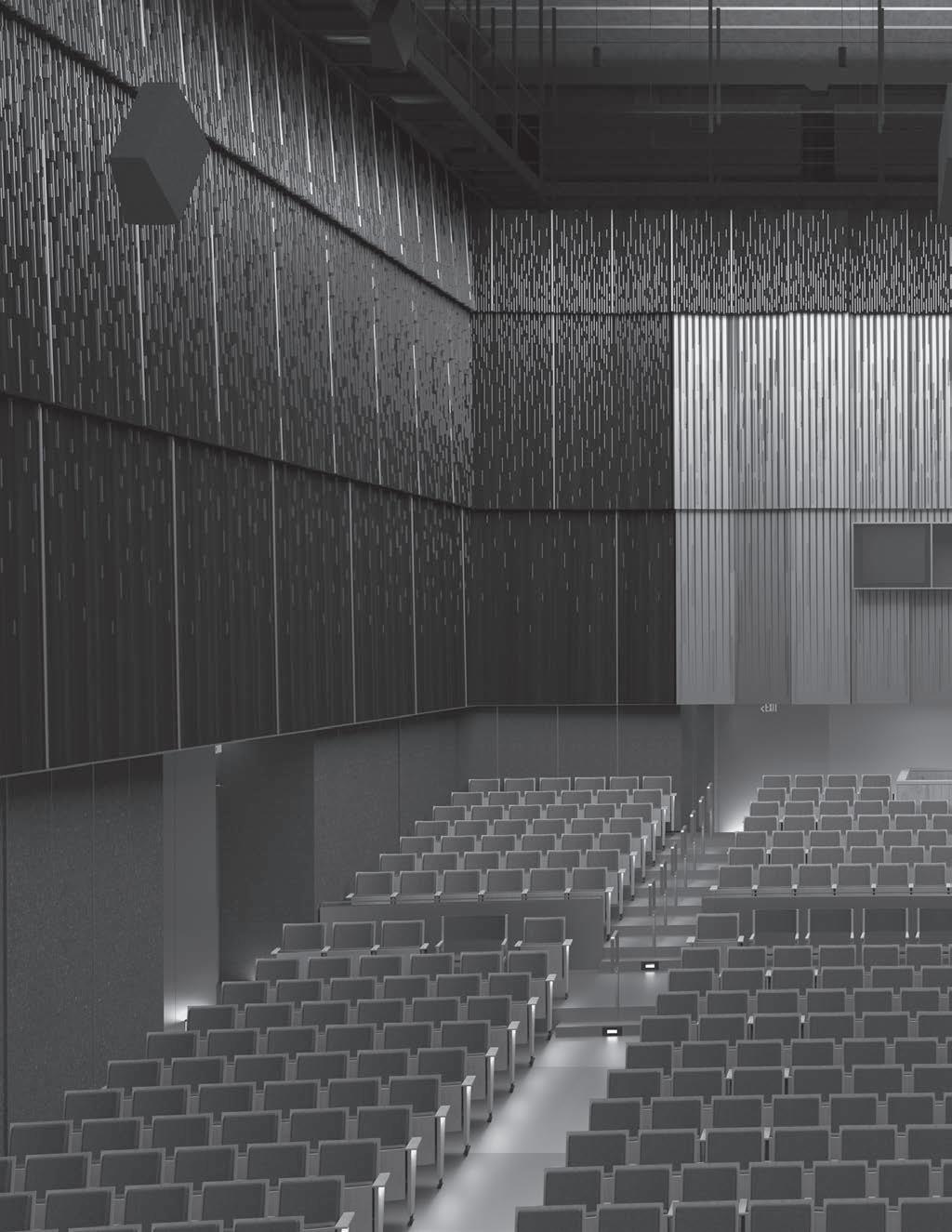

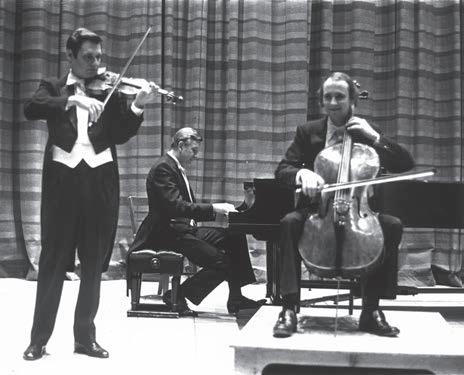
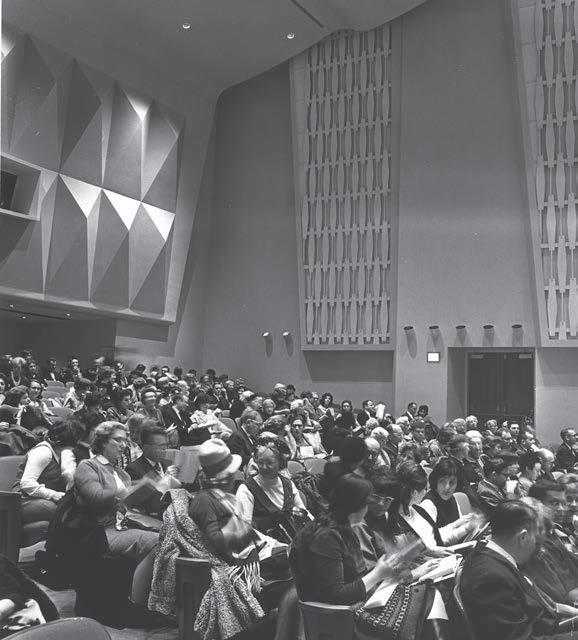
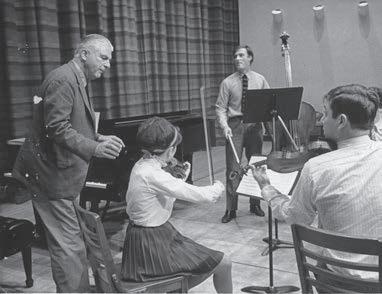
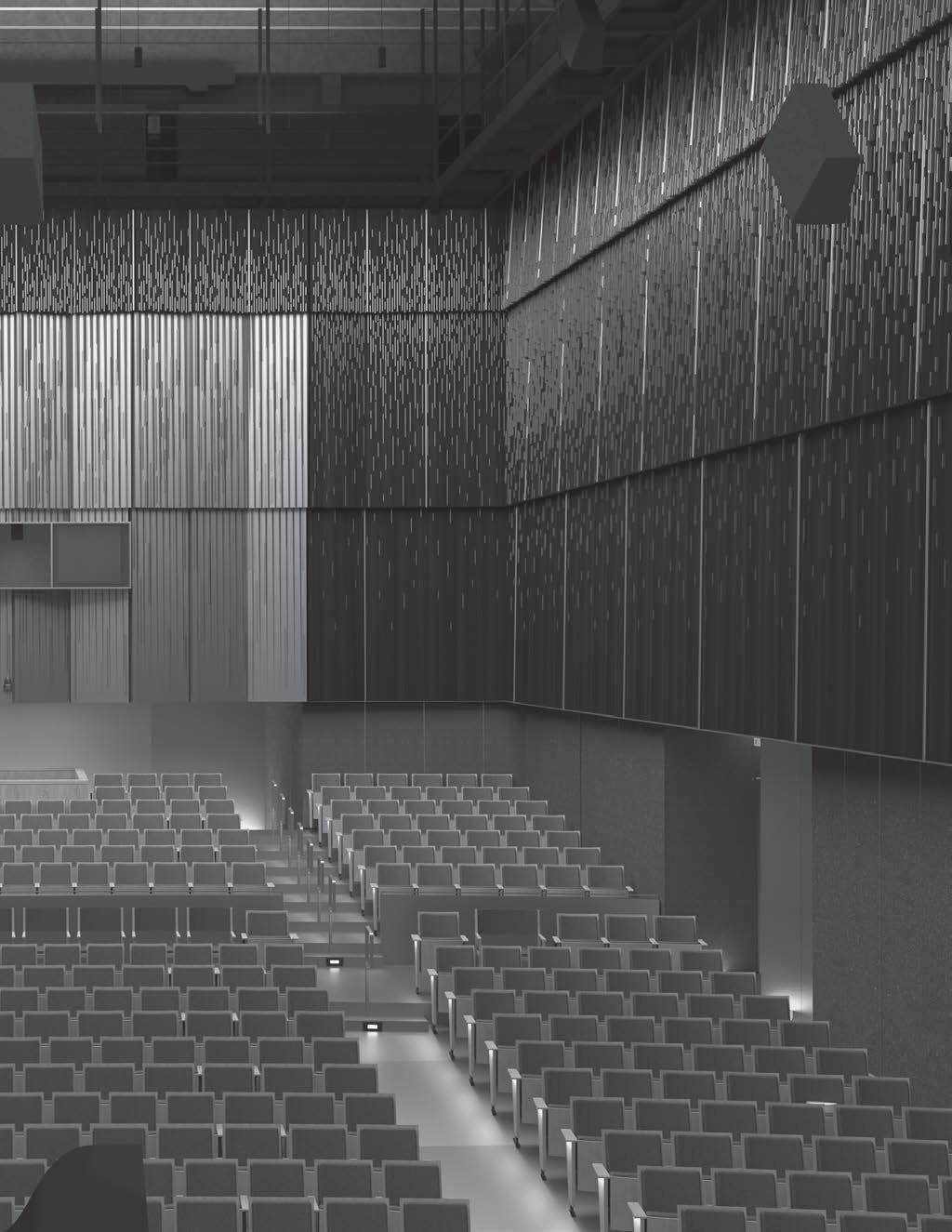

Sound without fury: In Kulas renovation, acoustics took top billing
Refined. Innovative. Supremely capable. In so many wonderful ways, the new Kulas Hall resembles CIM’s students and faculty.
This is very much by design. From the project’s inception through every step of construction, acoustics and the varying needs of students were top priorities, the drivers behind every decision large and small.
The result is a space that both preserves everything great about the old Kulas but also solves all the former sonic problems, a room that meets the artistic demands of today and will do so for generations to come.
“As far as we’re concerned, this is the crown jewel of Cleveland,” said Christopher Springthorpe, a senior consultant at Threshold Acoustics, the Chicago-based firm that collaborated on the renovation.
“We feel a wonderful sense of success. From a performance standpoint, it’s a truly exciting space.”
Success did not come easily. Indeed, in several regards, the renovation of Kulas Hall represented one of the more daunting projects in Threshold’s large portfolio.
That’s because, at CIM, acoustics mattered to an uncommon degree, and the hall’s central location within the school ruled out dramatic options, such as a complete rebuild of the physical envelope.
“For us, the hardest part was, how do we reform the room with the structural limitations we have?” said Dawn Schuette, the Threshold partner who oversaw the renovation.
Happily, limitations did not dampen creativity. On the contrary, just as the strict rules of 12-tone music have generated
sumptuous works of art, the boundaries of Kulas inspired any number of ingenious solutions.
Start with the hall’s upper half. Where once a low ceiling generated rapid and uneven reflection of sound, the redirection of HVAC ductwork significantly improved acoustics by facilitating the addition of some 30 percent to the room’s overall acoustic volume. Within this space has also been added a set of five reflector panels— four of them fully articulate and able to be raised and lowered—allowing users to shape the overhead area to meet their acoustic needs.
Hand in hand with this go new acoustical banners, around the perimeter of the hall’s new catwalk system. These accordionlike panels of wool serge can be raised and lowered partway into the hall to simulate every acoustic condition from
total, cathedral-like reverb to a heavily controlled practice environment for large ensembles.
“There’ll be a setting that works really well for a brass group or a string group or an opera ensemble,” Springthorpe said. “We’ll find those optimal spots, so that faculty can come in and just press a button and support that program.”
No less adjustable—or critical to the acoustics—is the orchestra shell, on stage. Composed of the same wood veneer as the stage itself, the 12-foot high, gently curved towers support sound equally around the stage and projects it efficiently into the hall, eliminating the hot-spots that Kulas Hall Renovation Task Force Chair Bonnie Cook (BM ’77) said were “very apparent” to students and listeners alike for decades. Furthermore, the shell sits on smooth-gliding casters, allowing it to roll forward, back, and rearrange with ease.

Light, stiff, and fully reflective, the recycled, British-made material preserves sound waves, keeping them alive in the room. At the same time, it resembles stone terrazzo, lending the hall a luxurious, timeless feel.
As a violinist in the CIM Orchestra, Cook recalled finding it difficult in the old Kulas Hall to hear herself and her colleagues, as conductors struggled to balance brass and percussion with the rest of the ensemble.
While a challenging acoustic environment can be educational to an extent, training young artists to adapt, “You don’t want a student spending their entire school career holding back,” Cook said. “The essence of what we’re trying to instill at CIM is to be a great listener. Music is a collaborative art, and your space can either help or hinder that.”
Suffice to say, the new Kulas Hall does the former, in spades.
Some of the most inventive acoustic problem-solving went into the side walls. Not only did designers think far outside the box to fashion walls both rigid and light (a solution described elsewhere in this issue) but they also covered them with wood terrazzo, a novel material that performs several key functions simultaneously.
In the new Kulas Hall, with the terrazzo, “All frequencies are reaching the ear closer to the same level they left the source,” Springthorpe said. “It just also happens to look really lovely, too.”
Threshold also had something to say about the position of the walls.
As the hall was being designed by architect Jonathan Kurtz, Schuette insisted the sides not face each other squarely. This, she said, would have produced an unwanted acoustic phenomenon known as “flutter.”
Happily, Kurtz avoided that pitfall, setting the walls at a gentle angle from each other, thereby promoting even distribution of sound. “We played around with the angle just slightly, to avoid that direct parallel situation,” Schuette explained.
All of this, of course, makes Kulas Hall an especially attractive place in which to record, a rival to neighboring Mixon Hall. This, too, designers seem to have anticipated, including among many technological improvements space for an audio engineer and lighting technician as well as abundant points of connection for
microphones and cameras. The new Kulas also boasts a screen for digital projections, a must in modern opera.
“Now they can sit in the room and do their mixing right there,” Springthorpe said, referring to CIM’s Recording Arts & Services staff and the many events they record and livestream. “From an operational standpoint, it’s a seamless means of facilitating that program.”
“Seamless,” it turns out, applies pretty well to the Kulas project as a whole. Threshold spearheaded the acoustics, but in truth, every party had a hand in ensuring the hall met CIM’s highest artistic standards. For that reason, Springthorpe likened the renovation to a Swiss watch, a complex system with multiple and cooperative moving parts.
Like a Swiss watch, too, the new Kulas Hall is a thing of manifold beauty. Thanks to the work of acousticians dedicated to bettering life for students, it’s pleasing not only to the eyes but also to the ears.
“We spent a long time thinking about this project, working through things,” Schuette said. “I think we retained what Kulas had but made it more robust. Everything was done very thoughtfully.”
A GEM IN THE MAKING
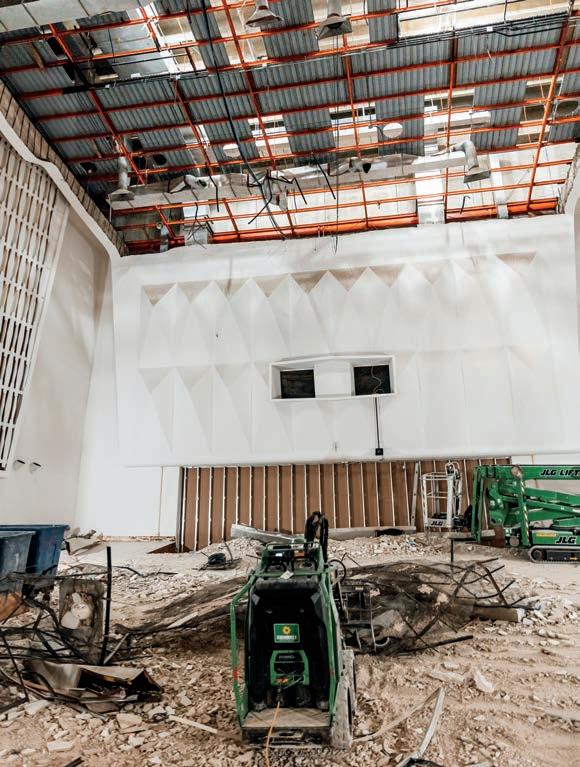
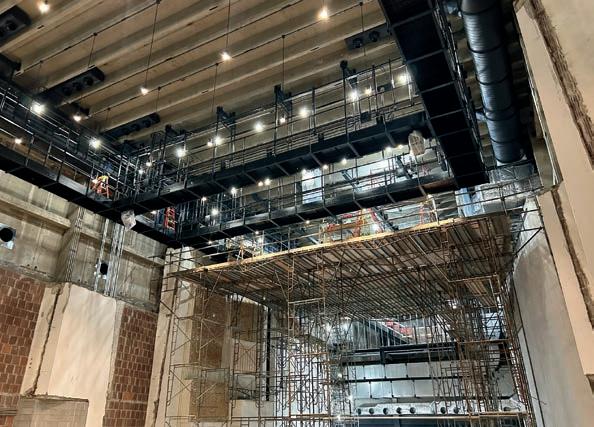


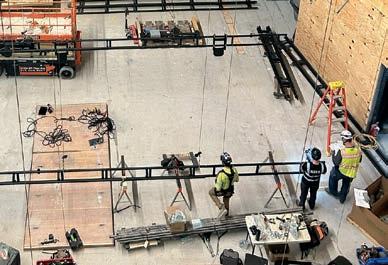
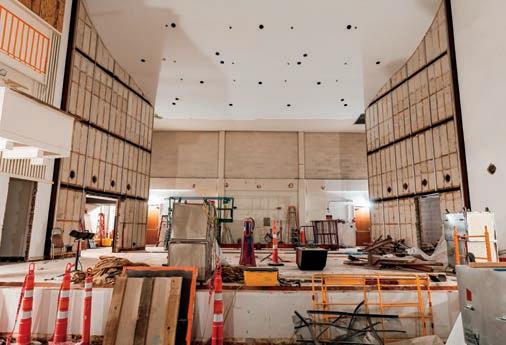
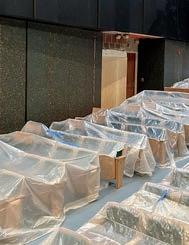
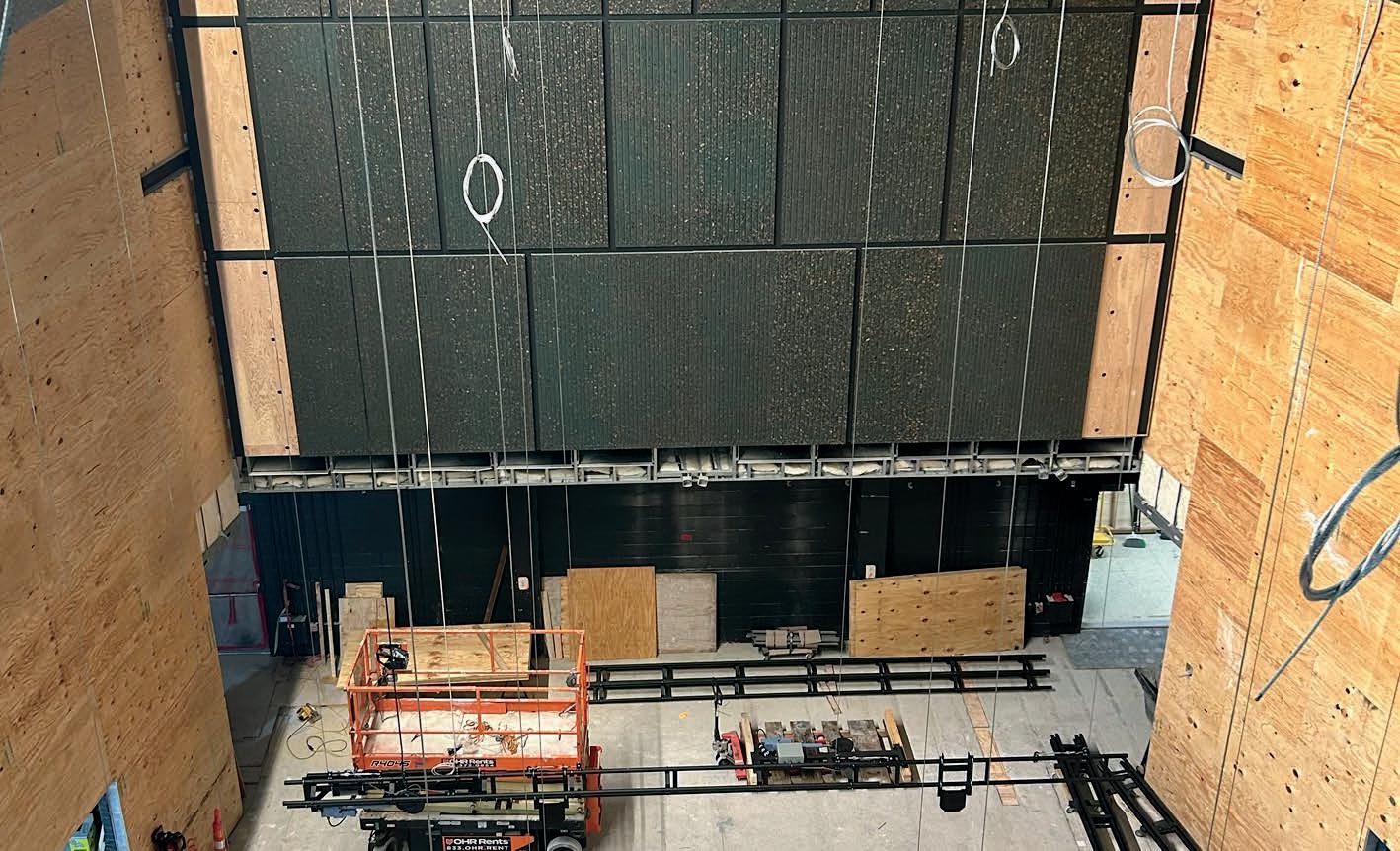
Turner Construction nails complex ‘choreography’ in renovation of Kulas Hall
If the renovation of Kulas Hall was a dance, the execution of the project by Turner Construction was a display of superb choreography.
New York-based Turner is used to working in active spaces, but the Kulas Hall project—with its emphasis on acoustics and location at the heart of CIM—presented several unique challenges. And yet the firm overcame them all, transforming Kulas while allowing students, staff, and faculty to go about their business normally.
“We were a guest in your house, and we had to work around you,” said Jack Kellogg, a project executive at Turner. “It’s something we always had to keep an eye on. We tried to make sure we had a work environment that people wanted to work in.”
Anyone who visited CIM between May 2024, when work began, and October 2025 witnessed the truth of that statement in action.
They saw the company operate out of a single short hallway at CIM and impinge on school life with only minimal noise and dust. They probably never experienced the loudest or dirtiest work, as most of that took place in summer 2024, when students were gone and staff worked remotely.
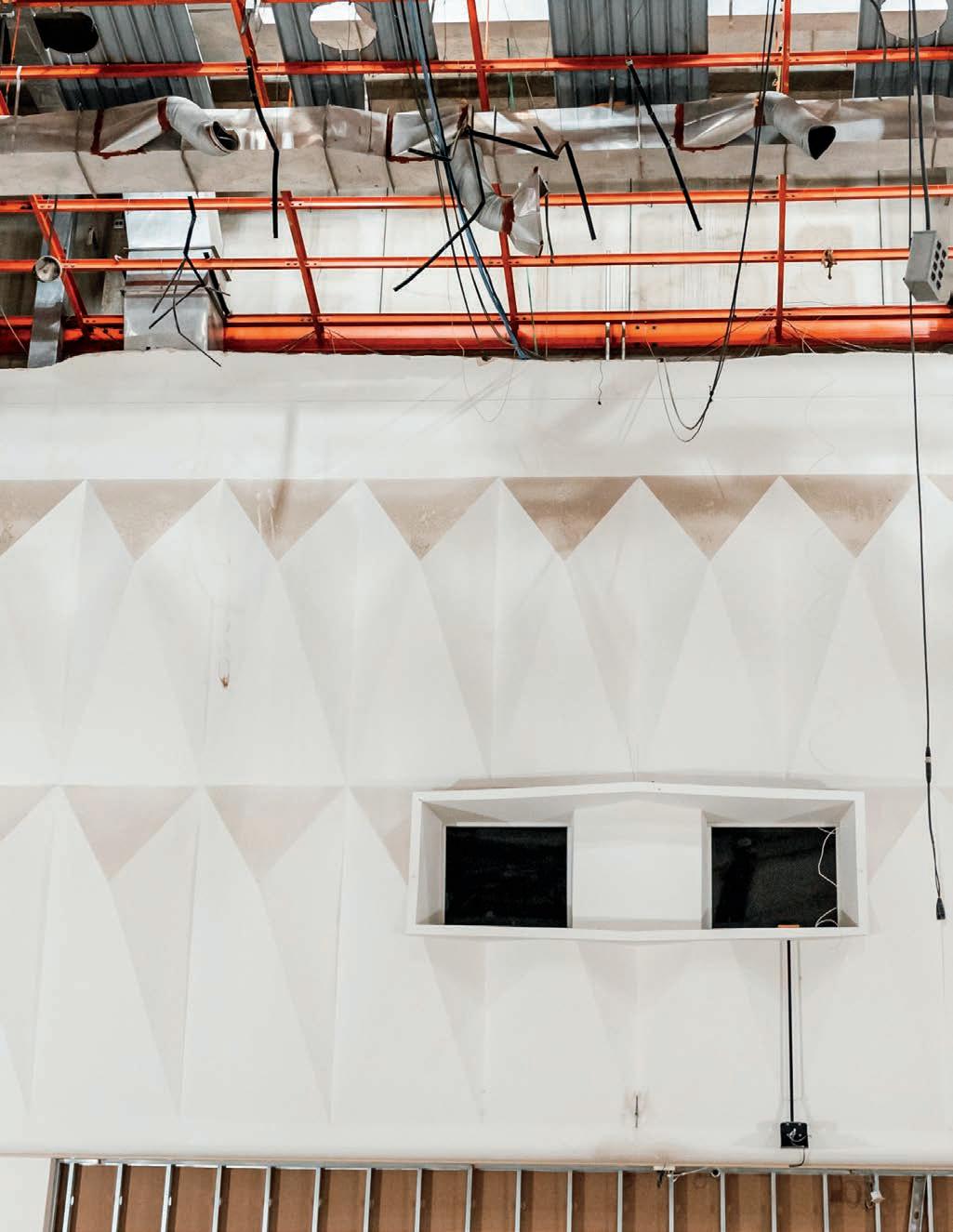
“Working in active venues is something we do quite a bit of,” Kellogg explained. “It’s kind of our sweet spot.”
That’s not all. To further minimize disruption, especially during the school year, Turner workers typically started early, often at 6am, and sometimes worked late shifts. When possible, too, they performed assembly work offsite, avoiding impact on CIM.
Almost all of this, of course, took place in a single room, a worksite unusual in that it put workers in tight quarters, obligating planners like Kellogg to schedule carefully, so that teams on scaffolding were never at risk of dropping materials on teams on the ground.
To put it mildly: it was complicated. Very complicated.
“There were a lot of steps, and it was a big challenge,” Kellogg said, noting one of the project’s largest and most unusual phases, the installation of wood terrazzo wall panels (made in England) and a custom soundproofing substrate onto a steel grid. “We brought in this super highend product from another country and had to marry it to a domestic product.”
But that was late in the renovation. Long before the challenge of the terrazzo walls came the HVAC
conundrum. Solving that problem elicited some of the deftest and most crucial choreography in the entire project.
Originally, all the school’s heating and cooling mechanisms ran through Kulas Hall, through a system of ductwork above the hall’s ceiling. At the same time, one of the project’s prime objectives was to increase the overall volume of the room.
The solution? Completely relocate the HVAC system to the exterior, onto the roof of the hall, thereby freeing up significant space overhead for better acoustics and theatrical equipment, including a new catwalk, and eliminating a potential source of noise. Kellogg called the move “a win-win all the way around.”
Jonathan Kurtz, head of Cleveland-based J. KURTZ Architects and the renovation’s lead designer, said the new Kulas Hall is both an aesthetic and a technical triumph.
“I think everybody will be wowed by the space,” he said, alluding to its intimacy and striking color palette. “At the same time, there’s so much behind the scenes that’s so complex, and nobody will ever know how much thought went into it. I hope people are able to tell that the guts of the hall are put together correctly.”
About that there’s unlikely to be much doubt. If Turner is known for anything in Northeast Ohio, it’s for putting things—sometimes very large things—together correctly.
In Cleveland, Turner is behind high-profile construction or historic renovation projects at the Maltz Performing Arts Center, the Beck Center for the Arts, and the historic Allen Theatre at Playhouse Square.
with important traditions to preserve—that inspired CIM’s Kulas Hall Renovation Task Force to hire Turner in the first place.
Turner “know[s] how to run a project and make it happen,” said Bonnie Cook (BM ’77), chair of the task force. “They’re so good at managing all the materials and teams. There’s a consistency and a reliability with Turner, in addition to an expertise.”
That proved important because, unlike most other projects in Turner’s portfolio, the Kulas Hall renovation was driven by acoustics.
Turner was used to creating spaces in which acoustics mattered, but Kulas was a space in which acoustics were everything. More than look good, every element had to sound good, too. One way or another, every piece down to the bolts had to contribute to the flexible, state-of-theart concert hall Kulas is today.
“It was very clear to me from the beginning that acoustics were the number-one priority,” Kellogg said, noting the complexity of the designs. “When I saw the renderings, I was really blown away.”
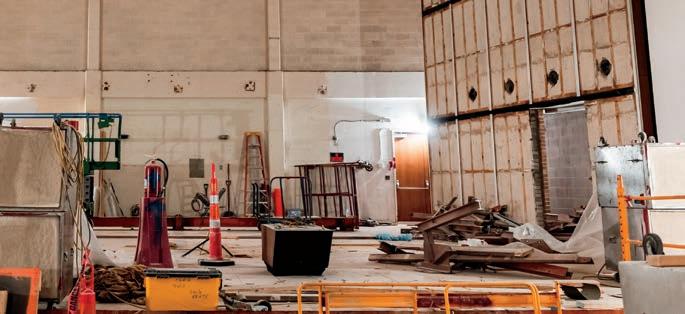
Less than a mile away, on the busy, densely populated campus of Case Western Reserve University, Turner is actively bringing to life an enormous new Interdisciplinary Science and Engineering Building, slated for completion in fall 2026.
Indeed, it was projects like these—in iconic, busy spaces
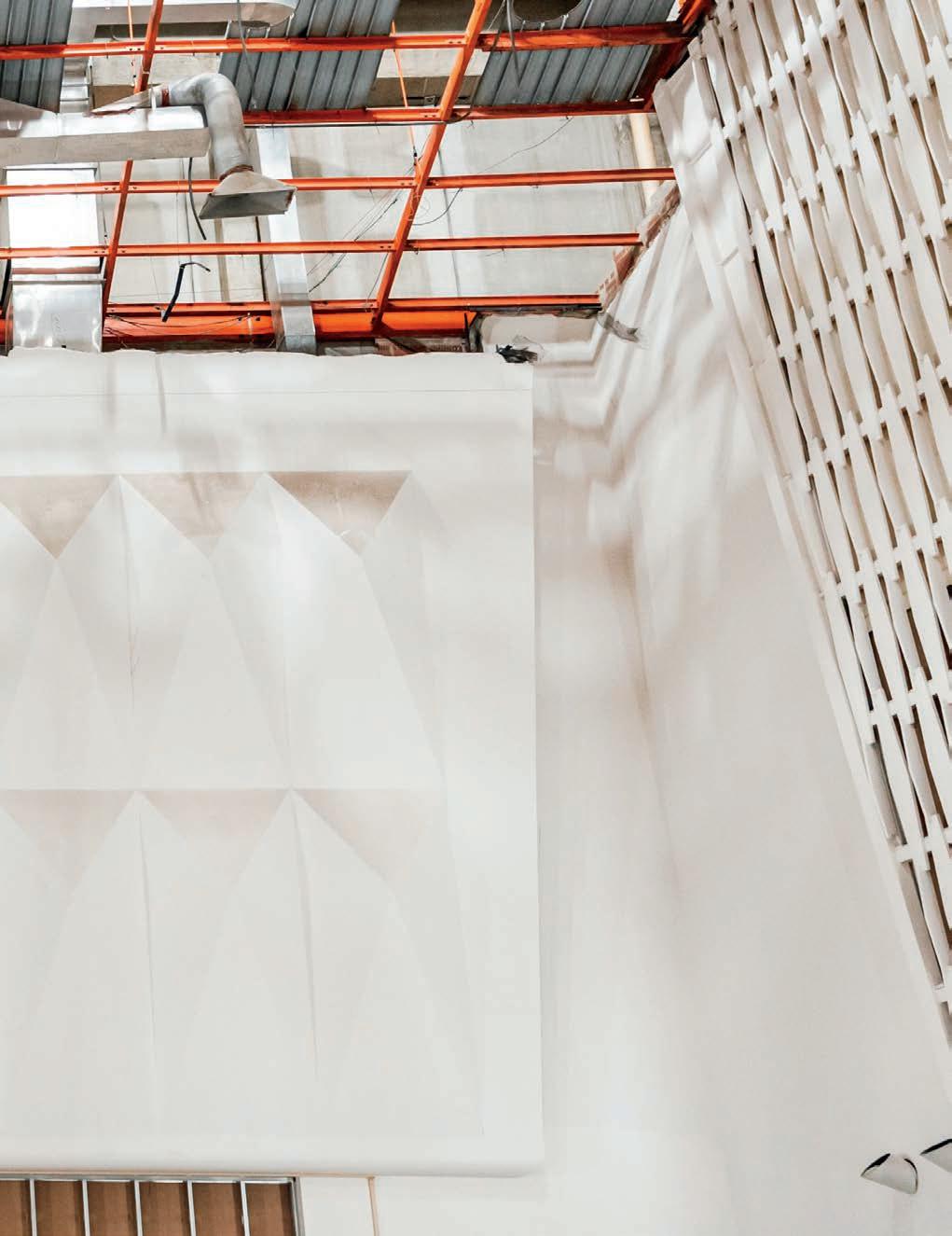
Now it’s CIM’s turn to be blown away—and yours. Everyone who attends a concert in Kulas Hall this season will get to experience the fruit of Turner’s labor, the stunning result of the company’s skilled, thoughtful choreography.
“They’ve been wonderfully efficient,” Cook said. “Every time I visit CIM and Kulas Hall, I’m reminded how fortunate we’ve been to have Turner.”
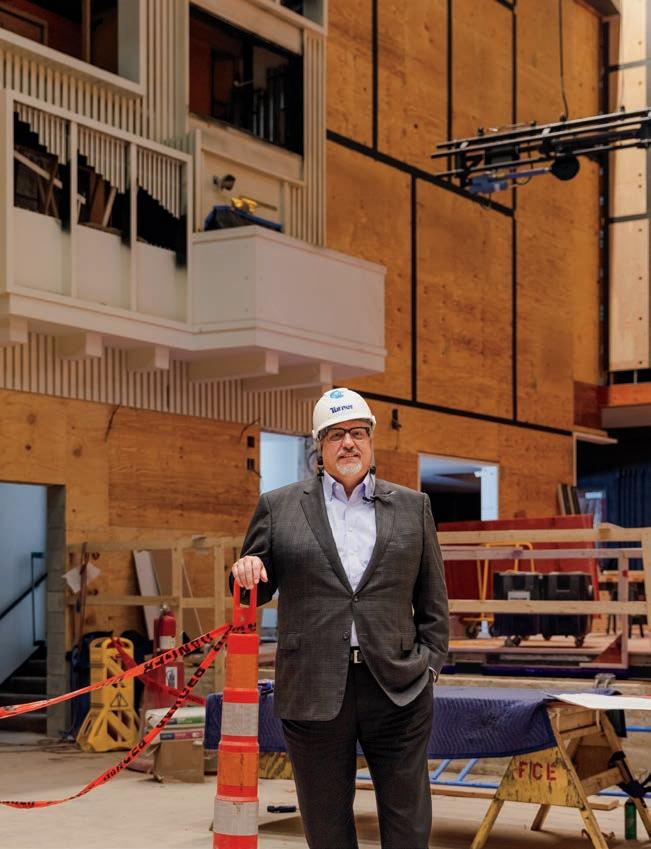
Kulas Hall organ holds special meaning for CIM Trustee Kevin Stein
Without a doubt, the renovation of Kulas Hall could not have proceeded without the generosity of Trustee Kevin Stein and his wife Kristen, whose $5 million gift ranks as the largest from a couple in CIM history. For them, though, the choice to get involved was easy. By funding the preservation, renaming, and refinishing of the hall’s organ and loft, they not only set up generations of students for success but also paid tribute to Stein’s father, Curtis K. Stein, who loved the instrument.
“The ability to name the organ loft, that was pretty cool,” said Stein, a CIM Trustee since 2021. “It’s a cool way to honor him. He would have really appreciated it.”
Unfortunately, Curtis Stein, who lived in New Hampshire, never visited CIM. He never got to hear the instrument that now bears his name and which already has helped advance the careers of countless young artists under the tutelage of longtime organ faculty Todd Wilson
But Stein is right: he would have loved it. Although Curtis often played the family piano—Stein’s mother was a piano teacher—he had a soft spot for the organ, and especially for the pipe organ. The grander, the better.
At church, Stein’s father played a simple console organ, but when he got home, the recordings he put on were of Bach, as played by pipe organ legend Helmut Walcha. Once, as a child, Stein said his father took him to hear the “Heavy Organ” of Virgil Fox.
“Of all the instruments, my father was always the most attracted to the organ,” Stein recalled. “He truly loved that music, and so, for that reason, I always associate my father with the pipe organ.”
A version of that affection lives on in the younger Stein, the former President and Chief Executive Officer of Transdigm, a lead supplier of aircraft parts.
Stein’s taste in music is wide-ranging, spanning everything from classical and jazz to all forms of rock. In his mind, organ music straddles two worlds, speaking to his love for classical music but also aligning with his fondness for “aggressive metal.”
“The pipe organ gives you that power, which can be hard to find elsewhere in classical music,” Stein said. “It’s such a unique instrument. I just love the sound and power of it.”
Now, thanks to the Steins, the sound and power of the Kulas organ—a three-manual, Holtkamp tracker with 35 ranks of pipes— will go on to serve many more students and listeners.
Indeed, safely reinstalled and shining anew in a renovated room, the Kulas organ will remain a highlight on the menu of free, world-class concerts that attracted Stein to CIM in the first place, and keep CIM at the heart of musical life in Northeast Ohio.
In the meantime, the first one to hear the reopened Kulas organ is likely to be Stein himself. As the one who helped fund its preservation, his hope is to pay respect to his father with a ceremonial performance of one of his and his father’s favorite pieces: Bach’s Toccata and Fugue in D minor.
“When everything’s done, I’ll ask someone to play it for me,” Stein said. “That’s my one request.”

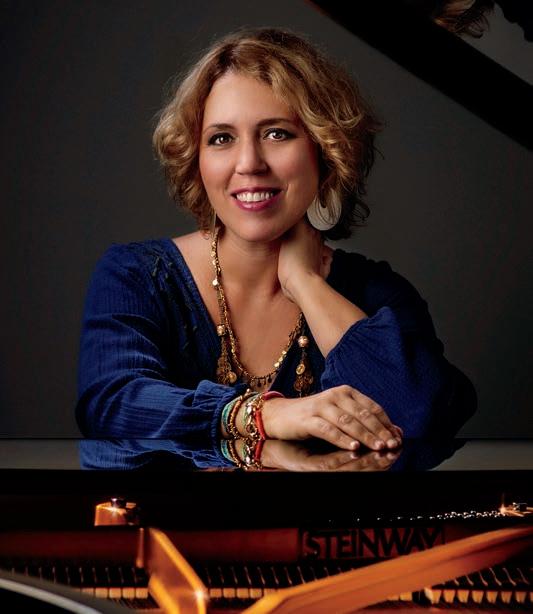
Renovated Kulas Hall inspires eclectic, starstudded fall season
The new Kulas Hall may be getting all the attention, but the main attraction at CIM this fall remains the music, the artists and programs it’s slated to host.
Indeed, the plans for Kulas Hall in fall 2025 are every bit as attractive as the newly renovated room itself, a resplendent array thoughtfully curated to showcase both the world-class talent at CIM and the hall’s incredible acoustics and flexibility.
“A new space is always invigorating,” said Tito Muñoz , the newly appointed interim principal conductor of the CIM Orchestra. “It’s like a new instrument for a building full of musicians.”
Muñoz is one of several prominent conductors headed to Kulas this fall. He’ll conduct Brahms and Korngold (and a movement from Tate’s Woodland Songs, featured elsewhere in this issue) October 17, but before and after him, CIM patrons can look forward to appearances by Kulas Foundation Visiting Artists Carlos Miguel Prieto and Andrew Grams.
Mike Block
Gabriela Montero

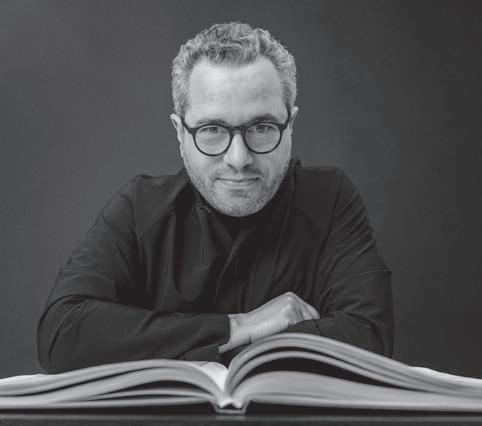
Prieto, in fact, music director of the North Carolina Symphony, will conduct the hall’s Grand Reopening Celebration, October 3. He’ll preside over a program including another Tate movement, Symphony No. 2 by Carlos Chávez, Moncayo’s Huapango, and the well-received “Latin” Piano Concerto No. 1 by CIM’s own Jonathan and Linn Epstein Artist-in-Residence, Gabriela Montero
After performing the concerto with major orchestras nationwide, “I get the feeling that audiences really understand the piece and like it,” Montero said. She said listeners are typically “seduced” by the work’s upbeat, rhythmic nature and then moved to discover it’s all a front, a metaphor for life in her native Venezuela. “What I’m trying to say is that beneath the façade, there’s a lot of injustice,” she said.
No less ambitious is Grams’ program for November 21. On the last orchestra concert of the fall season, the former assistant conductor of The Cleveland Orchestra will present another Tate movement, Strauss’ epic Also Sprach Zarathustra , and Prokofiev’s Piano Concerto No. 3, with student pianist Jakob Aumiller
“I think it’s a good balance,” Muñoz said. “They need to have these pieces in their hands and play them at a high level.”
The CIM Orchestra isn’t the only large ensemble headed to Kulas Hall this fall. On October 22, CIM will welcome back the Sphinx Virtuosi, the flagship ensemble of the Sphinx Organization. They’ll perform works from a wide range of cultures and eras to demonstrate the breadth and depth of Black and Latino composers.
Another large-ensemble concert awaits a little over a week later. On October 30, faculty violinist Todd Phillips will debut the CIM Virtuosi, a new conductorless group of 25 to 30 players he established last spring. They’ll perform Tchaikovsky’s Serenade for Strings and Mozart’s Piano Concerto No. 23, with faculty pianist Antonio Pompa-Baldi
“Students don’t realize it’s going to be this much fun,” Phillips said of the conductorless concept. “Then they want to do it every time. Without fail, they love it.”
A different sort of test awaits Kulas Hall this fall when CIM Opera Theater takes the stage. After a year performing off-site,
the school’s resident opera troupe returns to its renovated home with grand plans certain to put both students and the new venue through their paces.
The first program, November 7 and 9, is a double-bill of Puccini’s Suor Angelica and Gianni Schicchi. Smaller in scale as well as length, the pair of contrasting one-act operas are just the thing to expose students to Puccini’s work and to highlight the acoustics and new technology of Kulas Hall. After that, in early December, the group returns to Kulas with a program of opera scenes.
“This intimate double-bill will be well served by the hall’s size and enhancements,” said JJ Hudson, interim artistic director of CIM Opera Theater, of the Puccini operas. “We’re excited to return to Kulas Hall for this special opportunity to explore one of opera’s greatest dramatists.”
The rest of the fall calendar is chock-full of chamber music, of performances by small groups and renowned soloists from CIM and around the country. Together, they’ll complete the acoustic picture of Kulas Hall, complementing larger-scale events with an array of more intimate offerings.
Andrew Grams
Tito Muñoz
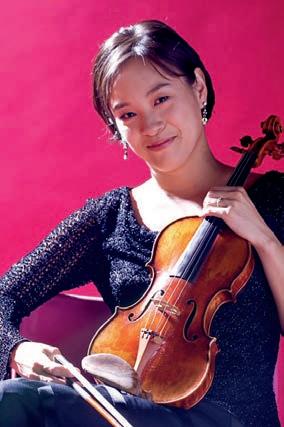
Kicking off the new season in Mixon Hall will be the New Music Ensemble, led by composition faculty Keith Fitch. They’ll devote a concert to the music of Luciano Berio, in honor of his 100th birthday. The same forces then return November 2, with the music of Chicago-based composer Shawn Okpebholo, and November 23, with a composition department recital.
Chamber music lovers will want to block off two dates in November, when CIM faculty and guests convene in Kulas Hall for what is sure to be some of the finest chamber music in Northeast Ohio this season.
On November 5, a group composed of cellist Si-Yan Darren Li, saxophonist Steven Banks , violinist Stephen Tavani (AD ’18), violist Wesley Collins (BM ’07), and pianist Anita Pontremoli (BM ’73) will perform Dvorˇák’s “Dumky” Piano Trio No. 4 and Tchaikovsky’s Souvenir de Florence. Two weeks later, Cleveland Orchestra members Charles Paul (double bass), violinist Genevieve Smelser (BM ’17), Gareth Zehngut (viola), and cellist Dane Johansen (BM ’05) will join forces with staff pianist Jacob Bernhardt (MM ’19, DMA ’23) on an eclectic program of Bach, Boulanger, Druckman, and Lerdahl.

Evidence of how much world-class talent resides at CIM is a series of four recitals by acclaimed CIM faculty and guests, two each in Kulas and Mixon Halls. Gracing the former will be faculty guitarist Jason Vieaux (BM ’95) on October 4, and pianist James Wei, winner of the 2024 Cleveland International Piano Competition, on October 15. Mixon Hall, meanwhile, will host faculty pianist Ilya Itin, September 24, and violinist Catherine Cho, a Kulas Foundation Visiting Artist, October 28.
Last but far from least, in a category by itself, is a visit December 3 by cellist and global music artist-in-residence Mike Block (BM ’04). After selling out Mixon Hall several times in recent years, he’ll likely do the same at Kulas Hall, this time with Kulas Foundation Visiting Artist Yacouba Sissoko, a master of the kora, a West African string instrument, and faculty percussionist Jamey Haddad
Muñoz, like many, can hardly wait. As a guest with the CIM Orchestra last year, he thoroughly enjoyed himself, even in lessthan-ideal spaces.
Now, it’s a whole new ballgame. He and the orchestra have a strong rapport on which to build and a glorious new room in which to make music at the highest level. From this potent combination, he said he expects great things.
“Having a hall like Kulas gives us more freedom to craft our artistic environment,” Muñoz said. “We’ve had a good introduction to each other and now we have a wonderful foundation to work with. I think everyone is excited and eager to get started.”
Catherine Cho
Sphinx Virtuosi
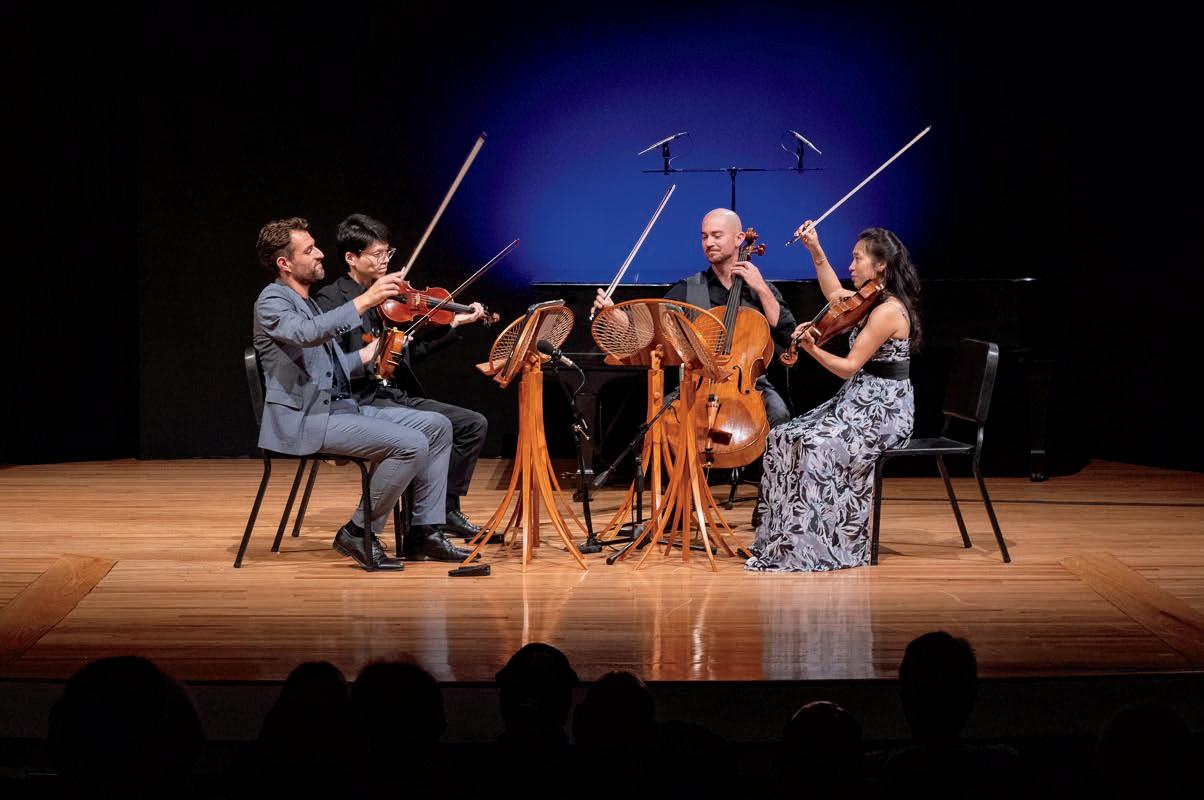
Welcome to the forest: CIM inaugurates Kulas Hall with premiere of Woodland Songs
The Consecration of the House wasn’t going to cut it. Not on this momentous occasion.
No offense to Beethoven or his famous overture, but for the grand opening of the newly renovated Kulas Hall, CIM needed something original. Something fresh. Something truly distinctive.
All those adjectives apply in spades to the piece CIM ended up choosing: Woodland Songs , by Jerod Impichchaachaaha’ Tate (MM ’00). A new orchestral song cycle in the composer’s Chickasaw tongue, the work fully suits the occasion, meeting the moment in both spirit and scope.
“I feel very blessed to have my tribal language sung at CIM,” said Tate, the 2022 recipient of CIM’s Distinguished Alumni Award. “CIM was critical to my development, and I hope this makes my school proud.”
Pride is one emotion Kulas patrons are likely to feel upon hearing Woodland Songs this fall. Another is enchantment.
Depending on which and how many programs they attend, Kulas patrons at the outset of the 2025-26 season will hear anywhere from one to all five of the work’s movements depicting animals for which Chickasaw clans are traditionally named along matriarchal lines.
They’ll hear vocalists and the CIM Orchestra embody through music the acuity of squirrels, the wisdom of woodpeckers, the mystique of deer, the undulations of fish, and the savvy of raccoons. Tate, who hails from the latter clan—known in Chickasaw as Shawi’Iksa’—and penned the libretto, said the music seeks to “amplify the wonderful personalities” of each animal.
Over the course of the hall’s opening weeks, the movements will be presented
one at a time, in performances featuring student soloists.
“That’s really how it should be,” said Tate. “Students need to be part of this. That’s the whole point of being a school. I was given that opportunity, and it’s critical that we give that back.”
That CIM chose Tate for the honor of helping to open Kulas Hall is no surprise. CIM has been proud of Tate for a long time.
Based in Oklahoma and one of the first to incorporate Native American languages, traditions, and melodies into Europeanstyle art music, Tate is among the most often performed and highly recognized composers of our time. He is a cultural ambassador for the U.S. Department of State, a member of the Chickasaw Hall of Fame, and an award winner from the American Academy of Arts and Letters.
The Dover Quartet premiered the original version of Woodland Songs. The CIM Orchestra will premiere a new version of the work for orchestra and voice.
Furthermore, the feeling is mutual. Tate is an avid supporter of CIM, a champion of a school he credits with spotting and nurturing his unique voice and establishing a lifelong network of friends and colleagues.
While pursuing a master’s degree in piano, with the late Elizabeth Pastor, Tate was encouraged by former composition head Donald Erb to pursue his interest in writing music – and to be himself. It was an aha moment, a turning point that started Tate down the trail he’s still blazing today.
Erb, Tate said, was “very supportive of me in all the right ways. He opened the floodgates for me. He gave me permission to go for it. I felt very much in company with him. I am spiritually very loyal to CIM.”
Once he started writing music, too, Tate said he was fortunate to have some of the finest student talent in the world at hand to perform it.
“I was saturated in some of the finest playing anybody could be around, ever,” Tate recalled. “I was like a kid in a candy shop. As a composer, at CIM, it was just unbelievable.”
It was with gratitude, then, that Tate prepared Woodland Songs for CIM, taking a work conceived in 2024 for string quartet and giving it new life with an adaptation for full orchestra and voices.
The core, at least, was set. A recent review of a performance in Texas by the Dover Quartet described “a complex work of depth and gravitas,” praising “highly
evocative” and “memorable” moments amid “much ingenious writing.”
Composing Woodland Songs , Tate said his goal was to capture the essential traits of his own and other Chickasaw clan animals: the boldness of squirrels, the tenacity of raccoons, the way woodpeckers see all, the elegance of fish in our “oceanic” rivers.
“These qualities are very much part of our identity,” Tate explained, adding that much of the music incorporates melodies from his and other clans as well as Chickasaw folk music.
Still, while those who heard the Dover Quartet surely enjoyed the piece, CIM patrons are in for an even greater treat. That’s because the new edition of Woodland Songs includes a vocal libretto consisting of poems penned in English and translated into Chickasaw.
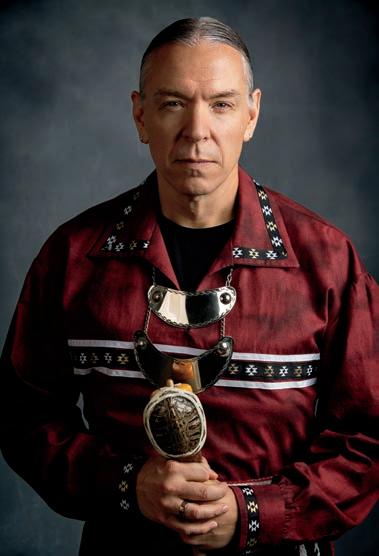
Tate said he wrote the lines with confidence, knowing they’d be performed by student singers, who in his experience are adept at picking up new languages – even those that aren’t the more conventional Italian, French, or German.
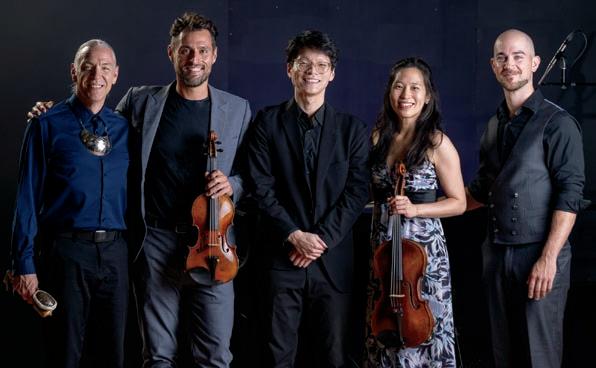
“Handing a new language to a singer, at CIM, you know they’re going to do it right,” Tate said. “It’s what they do.”
Tate also expects to take a certain amount of satisfaction from the performance as a whole. Having first imagined Woodland Songs for string quartet, he now looks forward to hearing the work in its new, more expansive form.
While the quartet version may have permitted a certain intimacy reminiscent of conversation, the new edition suggests something grander and more magical: a whole forest teeming with music, life, and new sonorities. A place, come to think of it, not unlike the new Kulas Hall.
“It’s nice to do this in two different ways,” Tate said. “They’re both equally valid and successful in expressing what I need to express. But this orchestral form, it’s an epic way of doing this.”
Jerod Impichchaachaaha’ Tate
GRACE NOTES
The pen was far mightier than the hammer at CIM this spring. Or at least more meaningful. Through an initiative called Grace Notes, hundreds of CIM community members put a personal touch on the new Kulas Hall, signing walls soon to be covered by acoustic paneling. Many simply wrote their names, recording their presence for posterity. Others, though, penned messages, some of them musical, stocking a vertical time capsule with words of friendship and support. Walls that would have remained blank for decades now stand fully, colorfully adorned, quietly waiting for some future generation to reveal them and imagine life at CIM in 2025.

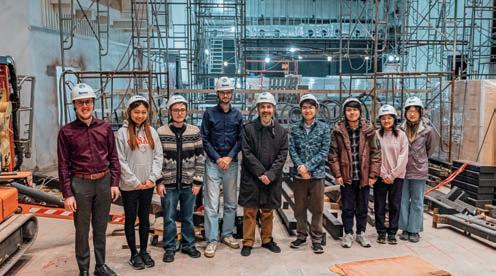
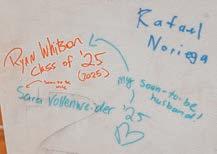
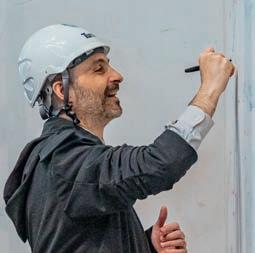

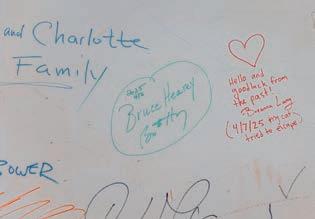
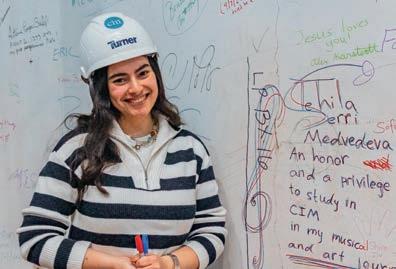
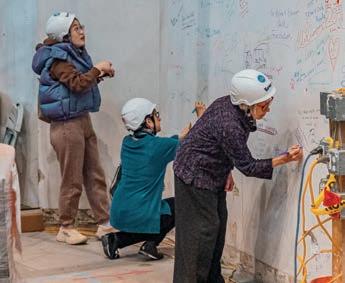
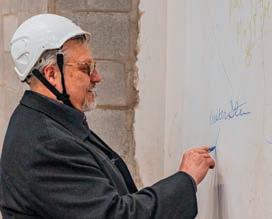


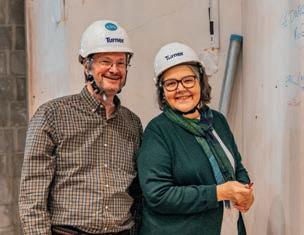
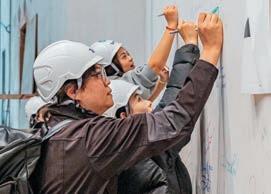
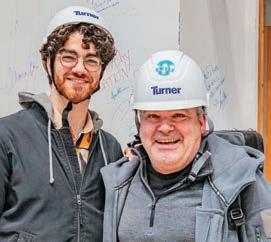
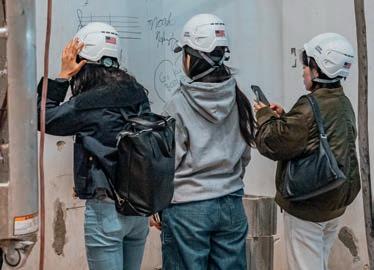
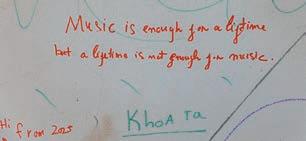
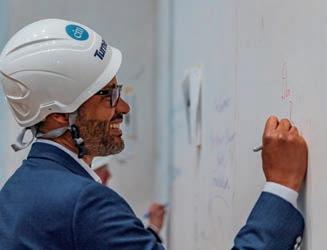

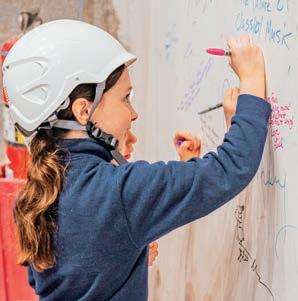

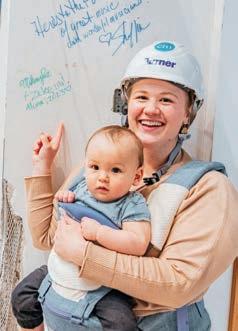
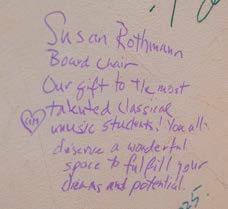

ALUMNI NEWS
Have some news? Visit cim.edu/alumni and click the Share Your News button. News is accepted on an ongoing basis and may be held for a later issue.
Alumni
Paul Aguilar (BM ’19, Laredo/Sloman) won the second and audience choice prizes at the 2025 Sphinx Competition.
Brian Allen (BM ’16, MM ’17, Laredo) was named first concertmaster of the Asheville Symphony Orchestra.
Davis Badaszewski (MM ’23, Wilson) was named among the 2025 “20 Under 30” class by The Diapason
Anthony Bracewell (BM ’13, Laredo/ Kantor) was named executive director of New York’s Naumburg Orchestral Concerts.
Jessica Chancey (BM ’21, Fink) accepted a flute teaching position at the University of Louisville School of Music.
Jiarui Cheng (BM ’20, AC ’22, Brown), Jonas Aumiller (AD ’24, Babayan), and Korkmaz Can Saglam (MM ’24, Babayan) were selected to participate in the 2025 Van Cliburn International Piano Competition.
Joshua Elmore (YAP 2015-16, Stees) was named principal bassoon of the San Francisco Symphony.
Chester Englander (BM ’99, MM ’01) was the subject of a feature article in The New Yorker : “The Man to Call When You Need a Cimbalom (a What?).”
Philippe Gagné (GD ’25, D. Shapiro) took first place and won the Marilyn Fischer & Joan Marie Scherer Scholarship at Tuesday Musical’s 2025 Scholarship Competition. Later, at the Annual Scholarship Competition Final Round/Winners Concert, he won the People’s Choice Award.
Brandon Garbot (YAP ’12, Preucil) was named second violinist of the Aviv Quartet.
Josué González (BM ’09, MM ’11, Kraut) was appointed Vice President of Education and External Engagement at the Boston Symphony Orchestra.
Arseniy Gusev (BM ’21, Fitch/Babayan) received a 2025 Award in Music from the American Academy of Arts and Letters.
Zubin Hathi (MM ’21, Damoulakis/ Yancich) was named principal timpani of The Cleveland Orchestra.
Remy Howard (BM ’22, Dixon) took second prize in the Orchestra Competition at the International Society of Bassists convention.
Rixiang Huang (BM ’17, Schenly/ Pompa-Baldi) released an album of Scarlatti sonatas on Naxos Records.
Kengo Ito (MM ’18, Damoulakis) was named co-principal percussion of the Royal Swedish Orchestra.
Christopher Jenkins (DMA ’25, Irvine/Ramsey) was named dean of the Conservatory of Music at Lawrence University.
Conrad Jones (BM ’11, Miller/Sullivan) was named associate principal trumpet of the Pittsburgh Symphony Orchestra.
Rachel Kost (BM ’20, Dimoff/Dixon) was named principal bass of the Firelands Symphony Orchestra.
Soo Ji Lee (BM ’17, DMA ’25, Brown) won in the open category of the 2025 Utah Philharmonic Orchestra Concerto Competition.
Qingzhuo Li (BM ’23, MM ’25, O. Kaler) took third place and won the Barbara Ainsworth Porter Scholarship at Tuesday Musical’s 2025 Scholarship Competition.
Kiana Lilly (BM ’22, MM ’24, Schiller) was a winner of the Indiana District of the Metropolitan Opera Laffont Competition.
Gregory Luce (MM ’09, Jackobs) was named managing director of Reed Yeboah Fine Violins.
Albert Mackey (BM ’22, Yancich/ Damoulakis) received a one-year appointment as associate principal percussionist of the Hawaii Symphony Orchestra.
Melissa Martinez (MM ’22, Schiller) was named a resident artist at Fort Worth Opera.
Boson Mo (BM ’11, Kantor) was appointed Affiliate Artist in Violin at the University of Houston Moores School of Music.
Pete Nichols (BM ’19, Yancich) was named assistant principal timpani and percussion section member at The Cleveland Orchestra.
Rafael Noriega (BM ’25, Hawes) was appointed to the U.S. Navy Band.
Emma Nossem (MM ’20, AD ’22, Schiller) was a winner in the Indiana District of the Eric and Dominique Laffont Competition. She also was appointed to the Metropolitan Opera Chorus.
Gabriel Novak (BM ’18, Fitch) was appointed Visiting Assistant Professor of Music at Reed College for the 202526 academic year. He also won a 2025 Award in Music from the American Academy of Arts and Letters.
Sam Rosenthal (YAP ’18, Irvine) won first prize in the 2025 Lionel Tertis International Viola Competition in England.
Sergio Ruiz (MM ’96, Schenly) was appointed dean of Angelo State University’s College of Arts and Humanities.
Kiarra Saito-Beckman (BM ’19, Laredo/Sloman/Rose/Ramsey) won the Howard E. Leisinger Viola Prize at Tuesday Musical’s 2025 Scholarship Competition. Later, at the Annual Scholarship Competition Final Round/ Winners Concert, she won the $2,000 Arden J. Yockey Scholarship.
Sebastião Sheldrick (BM ’24, Damoulakis/Yancich) joined the percussion section of the Erie Philharmonic.
Duo Shen (PS ’22, Topilow/ Parameswaran) was named an assistant conductor of the Cincinnati Symphony Orchestra.
Ani Sinanyan (MM ’24, I. Kaler/O. Kaler) joined the first violin section of the Civic Orchestra of Los Angeles.
Jerod I. Tate (MM ’00, Erb/Pastor) received a 2025 Award in Music from the American Academy of Arts and Letters.
JoEllen West (BM ’25, Wilson) took first place and won the Tuesday Musical Scholarship at Tuesday Musical’s 2025 Scholarship Competition.
Kathryn Wyatt (MM ’05, Konopka) was named executive director of Durham Arts Council.
Xuecong Sunny Xia (BM ’19, MM ’20, Sloman/Topilow) was named associate conductor of Seattle Opera for the 202526 season.
Muyan Yang (BM ’23 I. Kaler/O. Kaler) won a position in the New York Philharmonic.
Cicilia Yudha (YAP ’99, BM ’02, AD ’04, Radosavljevich) was appointed professor of piano at the University of Nevada, Reno.
STUDENTS
Owen Axelberd (composition, Fitch) won first prize in the 12th Annual Cleveland Composers Guild Collegiate Composition Contest.
Yifei Huang (voice, Schiller) took second place and won the Tuesday Musical Scholarship at Tuesday Musical’s 2025 Scholarship Competition.
Aubrey Williamson (viola, Irvine) took first place and Eduardo Muniz Villa (viola, Irvine) earned an honorable mention in the college division of the Ohio Viola Society Viola Competition.
Miaochen Yu (piano, Brown) won first prize in the senior division of the 2025 Lakeland Civic Orchestra Young Artists Concerto Competition.
ACADEMY
Defne Alhan (piano, S. Shapiro) was selected for the 2025 NEOMTA Young Artist Recital in Harkness Chapel.
Danelis Cedeño Calderón (guitar, Lara Alonso) took second place in the intermediate category of 12th Annual Latino Arts Guitar Festival and Youth Competition.
Jack Neely (cello, Pereira) was a co-winner of the senior division of the 2025 Cleveland Cello Society Scholarship Competition.
Mary Stachowiak (piano, S. Shapiro) was recognized as a Steinway Rising Star.
FACULTY/STAFF
Gregory Banaszak (saxophone) signed with Van B Korea Arts Management.
Keith Fitch (composition) had two works performed at the American Academy of Arts and Letters: Ruthless Voicings and as Earth dreams.
Marlina Karimi (executive assistant, executive offices) earned fifth prize at the 2025 Opera Birmingham Vocal Competition.
Antonio Pompa-Baldi (piano) released Italian Sonatas with Fabrizio Falasca, concertmaster of The Philharmonia.
Daria Rabotkina (piano) joined the International Steinway Artist Roster.
Julia Russ (piano, PS ’12, PS ’14, Friscioni/Pontremoli) and Sandra Shapiro (piano) won 2024 Steinway Top Teacher Awards.
Daniel Shapiro (piano) released Johannes Brahms: The Late Piano Pieces on the Centaur label.
Gerardo Teissonnière (piano, BM ’85, MM ’89, Vronsky) won a 2025 Governor’s Award for the Arts.
Carolyn Warner (chamber music) was named to the piano, violin, and chamber music faculty at the InterHarmony International Music Festival in Italy.
IN MEMORIAM
Kay Kleinerman (BM ’80) passed away April 7, 2025. She was a multi-talented scholar, educator, voice teacher, writer, and performer.
Seth Malkin (BM ’87) passed away in summer 2025. He was a longtime member of the Metropolitan Opera Chorus.
Deborah Nash passed away March 17, 2025. She was a CIM Trustee for 14 years, from 1981-95.
Myron Stern passed away February 27, 2025. He played flute and cello and studied theory and composition at CIM.
LIFETIME GIVING
Thank you to the many supporters past and present who have made a CIM education possible for generations and continue to shape the future of classical music. Below are some of the most generous donors, whose lifetime giving to CIM has exceeded $250,000 (as of July 21, 2025).
$10,000,000+
Cuyahoga Arts & Culture
The Fred A. Lennon Charitable Trust
$5,000,000–$9,999,999
Kulas Foundation
Barbara & Mal* (HDMA ’15) Mixon
Kevin & Kristen Stein and Family
$2,500,000–$4,999,999
Gay C. & Edward Addicott*
Mr. & Mrs. F. J. Callahan*
Ellen H. Hauck*
Elizabeth D. Hicks*
Barbara S. Robinson* (HDMA ’06) State of Ohio
One who wishes to remain anonymous
$1,000,000–$2,499,999
Hope S. & Stanley I. Adelstein*
Mr. & Mrs. A. Chace Anderson
Vitya Vronsky Babin Foundation
Eleanor H. Biggs*
The Cleveland Foundation
The Deane A. and John D. Gilliam Foundation
Clive & Mary* Hamlin
Linda Harper & Jim Martin*
Jean & Dick Hipple
Mort* & Emilie Kadish
The Kresge Foundation
Mr. & Mrs. Alexander McAfee*
John P. Murphy Foundation
Ohio Arts Council
Partners for CIM
The Payne Fund
Dick (HDMA ’06) & Pat* Pogue
Mrs. Alfred M. Rankin*
The Reinberger Foundation
Susan Rothmann, Philip Paul, & Jeremy Paul
Edith H. Smith*
Dorothy Richard Starling Foundation
Mr. & Mrs. Joseph H. Thomas
United States Department of Education
$500,000–$999,999
Ms. Ruth Beckelman*
Mr. & Mrs.* Eugene J. Beer
Helen C. Brown*
Ann C. & Hugh Calkins*
M.E. & F.J. Callahan Foundation
Irad (BM ’87, MM ’88) & Rebecca (BM ’87, MM ’89) Carmi
Mr. Arthur L. Charni*
Charlie & Grosvie Cooley
Rebecca & George* Dunn
Larry B. Faigin*
The GAR Foundation
Babs & Carl Glickman*
Margaret R. Griffiths Trust
The George Gund Foundation
Iris & Tom Harvie
Martha Holden Jennings Foundation
Sharon C. & Daryl A.* Kearns
KeyBank
Dr. Vilma L. Kohn*
Mr. Richard A. Manuel*
National Endowment for the Arts
C.K. “Pat” Patrick* & Nancy Patrick
Jane Kottler Post*
Audrey & Albert B. Ratner
Gail & Elliott Schlang
Mrs. Bert E. Siegel*
The Kelvin & Eleanor Smith Foundation
Two who wish to remain anonymous
$250,000–$499,999
Paul M. Angell Family Foundation
John & Elizabeth Aten
Mrs. Marguerite A. Barany*
Mr.* & Mrs. Alfred J. Buescher
Delores Comey*
Robert Conrad (HDMA ’98)
Virginia Deupree Crumb (BM ’77) and Carl & Jeanne Crumb
Dr. Mark H. Curley
Mr. & Mrs. John D. Drinko*
Alice S. Feiman* (BM ’32, MM ’36)
William O. & Gertrude Lewis Frohring Foundation
The Ann and Gordon Getty Foundation
The Dorothea Wright Hamilton Fund
Mrs. Beverly S. Harris*
The Hershey Foundation
The Albert M. Higley Co.
George M. and Pamela S. Humphrey Fund
Hyster-Yale Materials Handling, Inc.
Carter Kissell*
Joy Miller Kiszely*
Emma Lincoln*
Mrs. Elliot L. Ludvigsen*
Charley & Sue Marston
Mr. Joseph B. McClelland*
Meldrum & Fewsmith Communications
The Andrew W. Mellon Foundation
Laura Ingrid Messing*
Edith & Ted Miller*
David and Inez Myers Foundation
Ohio Department of Higher Education
Mr. & Mrs. Raymond P. Park
The Ranney Scholarship Fund
Peter J. Reichl*
Sam & Sarah Sato*
Astri Seidenfeld
Mr. & Mrs. Frank E. Taplin, Jr.*
Carole Hershey Walters
Ms. Annette E. Willis*
*deceased
Board of Trustees
Life Trustees
A. Malachi Mixon, III*
Barbara S. Robinson*
Chair Emeriti
Richard J. Bogomolny
Richard J. Hipple
Douglas J. McGregor
Joseph B. Milgram*
Robert F. Miller
A. Malachi Mixon, III*
Richard W. Pogue
Barbara S. Robinson*
KULAS HALL CAMPAIGN
CIM expresses its gratitude to the following supporters who have made the renovation of Kulas Hall possible (as of September 3, 2025).
$5,000,000+
Kevin & Kristen Stein and Family
$2,000,000–$4,999,999
One who wishes to remain anonymous
$1,000,000–$1,999,999
Kulas Foundation
State of Ohio
$100,000–$999,999
Mr. & Mrs. A. Chace Anderson
Mr. & Mrs.* Eugene J. Beer
Peter & Ellie Brodhead
M.E. & F.J. Callahan Foundation
Charlie & Grosvie Cooley
Robert & LaVerne Lugibihl*
Douglas & Charlotte* McGregor
The Roy Minoff Family
Barbara & Mal* (HDMA ’15) Mixon
John P. Murphy Foundation
Lisa, John, & James Robinson
The Kelvin & Eleanor Smith Foundation
Chris & Mary* Swift
Mr. & Mrs. Joseph H. Thomas
Mrs. Georgeanna Beaver Whistler* (BM ’49, MM ’51)
$25,000–$99,999
Cynthia Bassett
Eric (MM ’82, HDMA ’23) & Karen Bower
Bonnie M. (BM ’77) & David A. Cook
Robert R. & Gay C. Cull Family Foundation
Mr.* & Mrs. David Deioma
Rebecca & George* Dunn
Iris & Tom Harvie
Jean & Dick Hipple
Martin & Maria Hoke
Mr. & Mrs. Michael J. Horvitz
Walter & Jean Kalberer*
KeyBank Foundation
The Park Foundation
Shawn M. & Christine S. Riley
Susan Rothmann & Philip Paul
Gail & Elliott Schlang
Astri Seidenfeld
Jeffrey J. Wisnieski, MD & Janice Granieri, MD
$10,000–$24,999
Mr.* & Mrs. Alfred Buescher
Jeffrey M. Davis
Terrance K. Donley
The Jean, Harry & Brenda Fuchs Family Foundation
The Arthur E., Elsie G., & Betty M. Kranz Family Foundation
Mr. Mark L. Litzler
Charley & Sue Marston
Joe & Donna Perryman
Mr. & Mrs. James Stroud
Dr. Susan Reed Waller (DMA ’77) & Mr. D. Roger Waller
Daniel Tilles Weidenthal, MD
$5,000–$9,999
Stephen P. Ban
Constance Bergmann
Mr. Anthony Bianchi & Mr. Lloyd
Max Bunker
Lisa & Ronald Boyko
Michael Canty
Bonnie M. (BM ’77) & David A. Cook Family
Hank & Mary* Doll
Laurie & Robert B. Geho (BM ’91)
Ms. Karen Gottlieb (MM ’80)
Gary Hanson & Barbara Klante
Scott Harrison & Angela Detlor
Stephanie & Bruce Hearey
Lauri & Paul Hogle
Jeremy V. Johnson
Arthur Kane (BM ’70) & Stuart Friedman
Sharon C. & Daryl A.* Kearns
Mr. Dino Lustri & Mrs. Paola Galvis Lustri
John & Kimberly Malcolm
Deborah L. Neale
Dick (HDMA ’06) & Pat* Pogue
Katrina R. Redmond
James & Judith* Saks
Mrs. Carol Shaw
Mr. Duncan Stuart & Ms. Kathryn L. Eckhoff-Stuart
Philip & Sarah* Taylor
Mr. & Mrs. Mickey Weinstein
Richard Weiss & Joela Jones (BM ’66, MM ’67)
Thomas Zale
$4,999 or less
Mr. & Mrs. Michael Beedles
Margaret Calkins, PhD
Philip Eisenman & Gayle Ross (MM ’88)
Priscilla Fullerton
Lois S. Latnik (BM ’64)
Tim O’Brien
Allison Simpson
*deceased
Trustees Emeriti
Charles A. Bittenbender
Peter J. Brodhead
Brent M. Buckley
Robert Conrad
Rosemary Deioma
Terrance K. Donley
John D. Gilliam
Jeffrey P. Gotschall
Eleanor M. Hayes
Douglas J. McGregor
Robert F. Miller
Ma rilyn Sanders Mobley, PhD
Richard W. Pogue
Mrs. Alfred M. Rankin*
Astri Seidenfeld
John F. Shelley
Christopher J. Swift
Sonali Bustamante Wilson
Officers
Susan A. Rothmann, PhD
Chair
Eric W. Bower (MM ’82)
Vice Chair
Kevin Stein
Vice Chair
Katrina Redmond
Treasurer
Bonnie M. Cook (BM ’77)
Secretary
Board Members
A. Chace Anderson
Cynthia Bassett
Michael W. Beedles
Susan Silverberg Bewie^
President, Partners for CIM
Daniel J. Brown
Ann Buescher
Irad Carmi (BM ’87, MM ’88)
Charles P. Cooley, III
Jeffrey M. Davis
C. Thomas Harvie
Chair, Governing Members
Bruce Hearey
Richard J. Hipple
Paul W. Hogle^ President
Peter T. Kjome (BM ’89)
Jeffrey B. Linton
John L. Malcolm IV
Charles S. Marston
Roy D. Minoff
Shawn M. Riley
Elliott L. Schlang
Joseph H. Thomas
Titus Underwood^ (BM ’08)
Alumni Representative
Sanford E. Watson
International Council
Christoph von Dohnányi*
Michael Tilson Thomas
André Watts*
^ ex-officio *deceased
As of April 3, 2025
Be a part of CIM history by dedicating a seat in the new Kulas Hall!
For a one-time or multi-year gift of $5,000, any name or message of your choosing will be engraved on a plaque and affixed to the arm of a Kulas Hall seat, for the life of the seat.
Your gift of a named seat also confers the benefits of being a Governing Member for the year. These include private receptions, house concerts, concierge services, and voting privileges at the annual meeting.
To name a seat, send a message to development@cim.edu or call 216.795.3132.
